A Business Concept Proposal is a structured document that outlines the core idea of a business or project, its goals, target audience, and how it intends to solve a…
continue readingBusinesses need to utilize lead generation as it is a vital component of a sales-led organization. Without any leads to fill the sales funnel, sales representatives and the business itself have no idea who to contact or who to sell products and services. Most lead generation happens organically. It allows for genuine relationships and authentic connections with different consumers. However, it is still necessary to have a strategy for acquiring leads for B2B companies, and the B2B lead generation proposal is the key. What is a B2B lead generation proposal, and what is its significance to acquire more leads for the organization? The article focuses on equipping its readers with valuable information about the document, including its definition, composition, and a helpful guide in constructing the proposal. A section also addresses and answers frequently asked questions about the lead generation proposal.
4+ SAMPLE B2B Lead Generation Proposal
What Is a B2B Lead Generation Proposal?
A B2B lead generation proposal is a document that outlines the problem of the client and details a plan that proposes a solution. Creating a detailed lead generation proposal can win work because they provide relevant information for prospective clients for them to understand the overall strategy for solving their problem. At the same time, it highlights the expertise and skills of the company and the unique service that the company offers. The most relevant aspect of the lead generation proposal from a client’s point of view is the approach of the company regarding the lead generation project, the proposed procedures that the company uses to generate leads and qualify them, and how much the company expects to charge a client for its services. The lead generation proposal that the company creates must be more than just outlining the solution strategy to bring more qualified leads to clients. It must also create a positive impression on clients, build trust in the marketing abilities of the company, showcase industry knowledge, and set the pace of a project through a work schedule. If the company showcases all of these, it is more likely for the company to win work for lead generation projects.
According to the study from HubSpot in their report, Not Another State of Marketing Report for 2021, roughly 61 percent of marketers are already considering generating traffic and leads as their biggest challenge. From the same report, about 18 percent of marketers think that outbound practices still provide the highest quality sales leads.
Components of a B2B Lead Generation Proposal
The more detailed an individual creates a B2B lead generation proposal, the less room there is for disputes or misunderstandings to arise. Although the proposal writing process in itself is tedious work, it is worth the time and effort to accomplish it correctly. A detailed lead generation proposal that the company creates can easily be a format for a lead generation proposal that the organization can utilize at a later date. It makes writing the next and future proposals easier and faster to create and develop. Having a personal template allows the company to have the essential elements for each proposal and make every sales or marketing pitch reliable for a new project. The section below describes and lists all of the vital components for a comprehensive B2B lead generation proposal.
If the company plans to use inbound lead marketing, the proposal must have details of the tools it intends to use. Engaging content that results from inbound marketing includes landing pages with prospect details, email marketing, and online content like web blogs and infographics. The content sparks anticipation and interest in new audiences. Promoting the content is as vital as its creation. If the forte of the business is outbound marketing techniques, it must include the various lead generation tool that the company plans to use, including cold calling, direct mail marketing, direct messages, and the platform the company intends to use. The lead generation process is a vital part of the lead generation outline.
It explains how the sales team plans to generate leads for a client, how they pass this information over to the client, and any other lead nurturing activity and services from the company. Different marketing tools, like CRM platforms, track and score sales leads for the sales and marketing team must be available in the outline. Having clear communication channels spells success once the project commences. The lead generation process must also include a work schedule that indicates project milestones, deliverables, and deadlines. The schedule is a great way of showing what you want to accomplish, how to generate new leads, and when to achieve interim targets and project goals. The lead generation strategy must also incorporate a way to measure success.
It can be through an increase in the number of leads, a percentage increase in lead generation activities, or the impact of delivery on sales processes. No matter the method and services the company chooses for the client, it must yield a return of investment or ROI from selecting the proposal among many others.
Payment terms: The payment terms section is a vital component of any lead generation proposal from the point of view of a client. It is also one of the parts of the proposal that rarely undergo major changes. Payment ties itself to each new lead for the client, either for the business, the product, or its services. It is also necessary to define what constitutes a new lead to avoid any ambiguity in payment. Retainers and bonus plans are another way to charge for lead generation activities. The payment terms section also includes payment invoices and schedules. Review this section of the lead generation proposal yearly to make sure it is in line with the projects that the company is launching.Legal terms and conditions and additional information: This section of the proposal must reflect the understanding and knowledge of the company regarding the terms and conditions for lead generation activities under the Federal Trade Commission. It must state how these outbound activities remain compliant with the Telephone Consumer Protection Act. It assures the client that the company delivers its services under lawful means. The section also contains additional ideas for the project, provided services to support work with the client, expert team members working on the project, and any other relevant information. It helps the proposal stand out and instill confidence in the client.Summarization and closing statements: The ending statement is as impactful as the beginning. In the proposal summary, make sure to restate the problem of the client, the proposed solution, and the method for implementing the lead generation activities. After, indicate that section where the client agrees to enter into a contract for a lead generation campaigning to follow. Despite having to customize the name of the client in this section, a large portion of the section remains the same.How To Write a B2B Lead Generation Proposal
As there is an order of writing the components of a business proposal, the same system does not apply to a lead generation proposal, and you can refrain from writing one in that style. However, it is often easier to start by outlining the potential problems of a client and the strategy to solve their case by generating leads. The section below details a useful guide to help you write a B2B lead generation proposal for clients.
-
1. Figure Out What the Client Wants To Solve
The principal purpose of writing the B2B lead generation proposal is to identify what the client needs and how you are planning to solve their problem. Whether the company is responding to a lead generation tender or following up a sales call with a client, you must show a clear understanding and knowledge of what the client wants to achieve for you to write comprehensive and meaningful lead generation proposals.
-
2. Put Some Clarity on the Lead Generation Project
Outlining the needs of a client is a necessary aspect of the B2B lead generation proposal. It shows the client that you understand the lead generation problem the client to help crystallize the ideas to create the best and most viable solution.
-
3. Provide an Explanation of the Lead Generation Strategies
Give an outline of the solution and provide in-depth information on the process you will perform and deliver promised services. Indicate the different activities that you will use to generate the leads, the various tools you will use to sell and market the business, and other techniques that you will use to solve client problems. Incorporate a schedule for the work that indicates the people, procedures, and dates for particular activities. If there are particular activities that other teams accomplish, state their names and their responsibilities. The content plan must establish the topics, the type of content, and the creative procedure and delivery of inbound marketing activities. Outbound marketing activities, like direct mailing lists and calling prospects, must have work schedules. The person performing these specific tasks must reflect on the lead generation proposal.
-
4. Emphasize What Makes the Company Different from Others
To stand out, make sure to emphasize the services you offer from other companies. This is the process of finding and securing leads, expressing vast sales and marketing experience in the field, highlighting the unique approach to lead generation activities, and any other way that you can add value to the client. It helps to maintain a particular image of the company to the client.
-
5. Demonstrate the Lead Generation Results
It is not enough to attract clients by stating that clients value the various lead generation methods you implement. Back these claims by providing results with factual data and figures accompanying customer testimonials about the services you provide to help the lead generation proposal stand out from the rest.
-
6. Add Supplementary Sections To the Proposal
After establishing the main components of the proposal, add the payment terms, introduction, additional information, final summary, and closing statements. After accomplishing all the necessary components of the proposal, reviewing and proofreading the document ensures that no information goes missing.
FAQs
How do you generate leads for B2B?
There are various techniques for generating leads for a B2B company, it includes:
- Sending cold calls and warm emails
- Setting up a live chat on the website to keep conversations going
- Updating the email signature with embedded promotions
- Joining relevant social media groups and pages
- Getting more positive customer feedback
- Using SEO methods to increase traffic
- Utilizing press releases for more leads
How much do lead generations cost companies?
According to marketingcharts.com and their 2017 Demand Generation Benchmark Report, the average cost for each lead accounts for 198 US dollars. However, now, it varies depending on the industries utilizing lead generation.
What is a lead generation process?
Lead generation is a marketing process that stimulates and captures interest in a product or service to develop a working sales pipeline that allows companies to nurture these leads and translate them into revenue in the future.
The purpose of lead generation is to increase the growth and development of the company. The entire process builds visibility, credibility, trust, and confidence from specific groups, communities, and industries. Focusing on producing valuable lead generations can help generate traffic from high-quality prospect clients, and through these individuals come high-value consumers. Generating leads for the company is vital. As such, writing a B2B lead generation proposal takes a sufficient amount of time and effort. Download a lead generation proposal from the 4+ SAMPLE B2B Lead Generation Proposal in PDF, only at Sample.net.
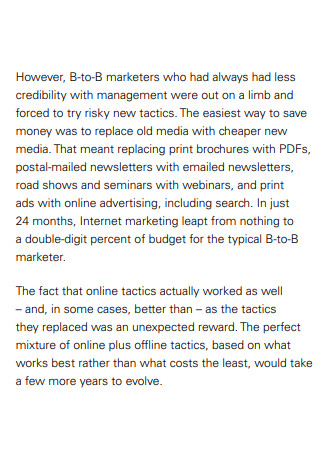
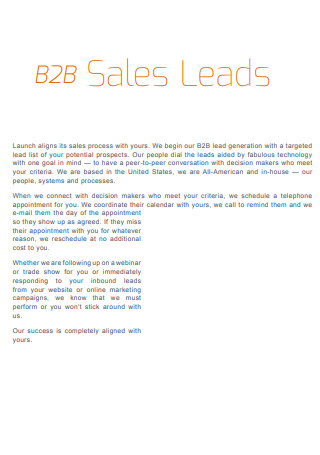
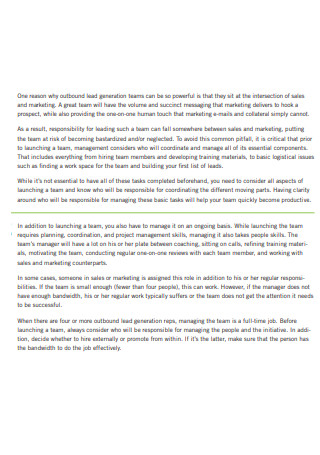
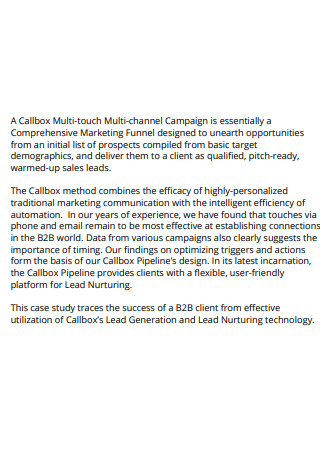
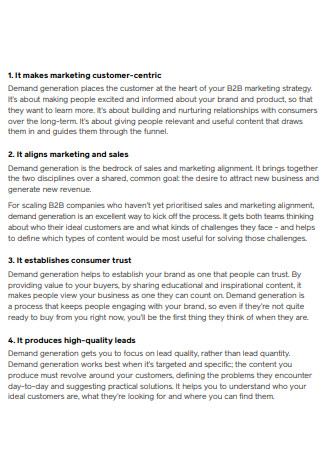
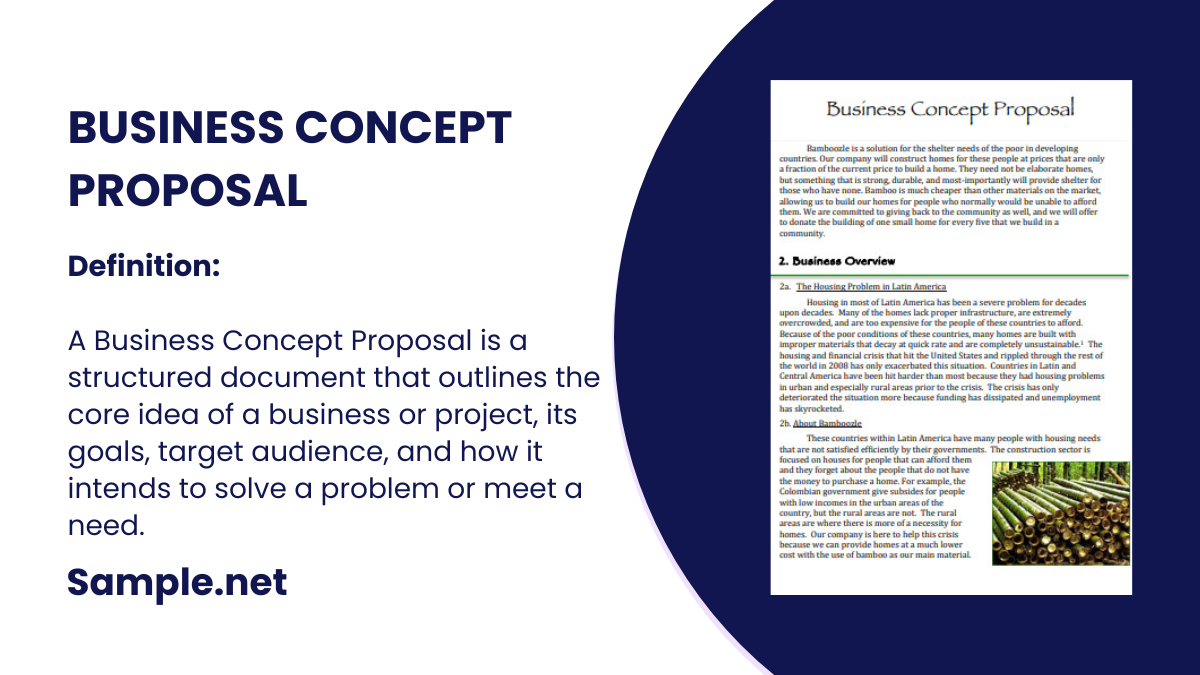
![25+ SAMPLE Marketing Budgets [ Business, Plan, Digital ] marketing budgets](https://images.sample.net/wp-content/uploads/2021/02/Marketing-Budgets.jpg)